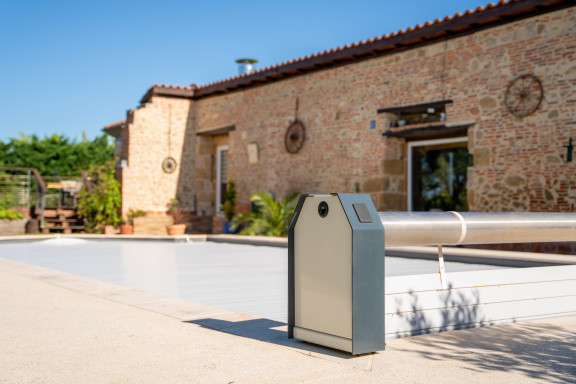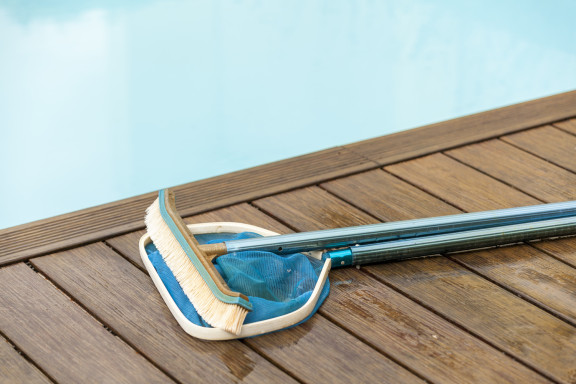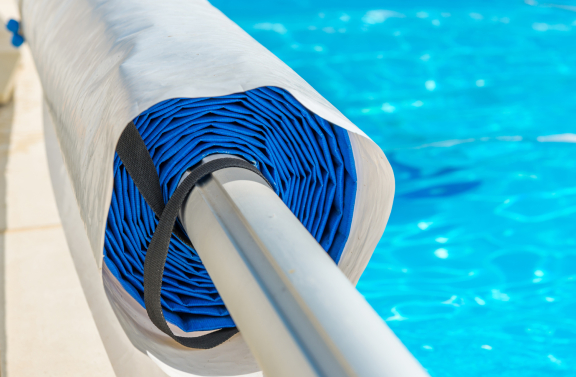Why should you install a bioclimatic pergola?
The customizable, comfortable, easy-to-look-after, stylish bioclimatic pergola enchants an ever-growing number of French people looking for a solution to help them make the most of their outdoor spaces. The bioclimatic pergola's success has meant that, over the last few years, its rivals, i.e. the traditional pergola and the veranda, are finding it rather hard to keep up. So, should you too yield to temptation and install a bioclimatic pergola? Discover the many reasons that could convince you to take the plunge and go ahead with your project.
Traditional pergola VS bioclimatic pergola
You're probably one of the many people thinking about and looking for a solution for equipping their outdoor spaces so you can enjoy being outside without suffering from the heat. The pergola, in the widest sense of the term, designed to add shade to an outdoor space (like a terrace), has become highly-popular in French people's gardens. There are two types of product on the market today that compete fiercely with each other: the pergola referred to as "traditional" and the pergola referred to as "bioclimatic".
The traditional pergola
This pergola model is the most affordable and is perfect for creating shade in an outdoor space while keeping a tight rein on your budget. This type of pergola can be made in wood, aluminium, iron or PVC and is generally easy to install, as a lean-to against your home or as a free-standing structure in your outdoor space. By essence, the traditional pergola delights anyone looking for a cost-effective solution to be protected from the sun's rays, especially if you have a few DIY skills.
The bioclimatic pergola
The bioclimatic pergola arrived on the pergola market more recently than its older sibling and revolutionized the pergola sector with its great promise: to offer protection to outdoor spaces from the sun as well as from the wind and the rain. With its roof and its adjustable slats, the bioclimatic pergola does indeed tailor to weather conditions and changes, and remains resolutely stylish. With a bioclimatic pergola, you'll be able to control the temperature of your terrace easily and you'll have the opportunity to make the most of your outdoor spaces, even if it pours down. The bioclimatic pergola is also more time-resistant and tends to have a longer service life than the traditional pergola. What's more, it sets off your home with its great style and, if ever you're thinking of selling and moving, it will add quite a bit of value to your property.
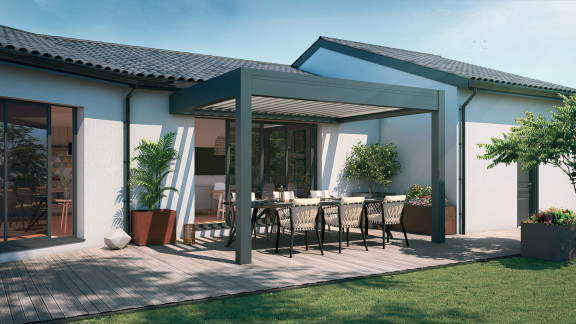
Bioclimatic pergola VS veranda
You'll have another unavoidable choice to make before you opt for a bioclimatic pergola in your garden. The bioclimatic pergola, now taking pride of place over the traditional pergola, still needs to prove its just as good (if not better) than a veranda to earn your trust. Most people tend to make detailed for/against comparisons between the bioclimatic pergola and the veranda before making up their minds and going for a bioclimatic pergola.
The veranda
The veranda, created and sold as a solution that gives you an extra space to live in and that can be used in all seasons in a home (it's often thought of as a home extension), includes a series of building phases that traditional and bioclimatic pergolas don't require. As the veranda is totally closed, it has to be insulated with good-quality materials to ensure there's not too much difference between the veranda temperature and that of the living area inside the home that it's connected to. The veranda is often designed and fitted out like a real room in its own right, so it needs to be perfectly weatherproof (water leaks are never welcome in a veranda). On the comfort side, the veranda can occasionally turn out to be stuffy, overly-hot, when directly exposed to the sun's rays, and the temperature inside the veranda can rise quickly; or, on the other hand, it can be pretty chilly in bad weather. Although this aspect isn't bothersome and can be even appreciable in spring and autumn, it can however become a disadvantage when summer heatwaves and the winter freeze come around.
The bioclimatic pergola
The bioclimatic pergola is generally open and provides a space that's protected from the sun and bad weather, yet it isn't hampered by the different constraints a veranda has. By choosing suitable options (vertical blinds or glazing, installing a heater, an integrated lighting system, power sockets, etc.), it can be very much like a veranda as regards living quality in this extra "room". When it comes to the price quote, the bioclimatic pergola turns out to be more appealing than the veranda as its price is more affordable for a similar home design solution.
Benefits of the bioclimatic pergola
The host of benefits a bioclimatic pergola offers, mentioned quickly when we compared the veranda and traditional pergola, largely justify the growing success this outdoor equipment has been enjoying in recent years. We can highlight five key benefits when it comes to installing a bioclimatic pergola for your home.
The bioclimatic pergola optimizes your outdoor space
There's no denying that. The bioclimatic pergola means you can enjoy your terrace and your garden more (under better conditions and for longer). With the bioclimatic pergola, you'll never have to worry about eating meals in full sunshine or a parasol that doesn't stay stable when you're trying to doze off in the shade. By moving the adjustable slats of the bioclimatic pergola, which doesn't require any effort, you'll choose the amount of sunshine and light you wish yourself to meet your needs and your activities.
A bespoke bioclimatic pergola in line with your tastes and needs
Do you like your outdoor spaces to reflect your personality? Just like a veranda, a bioclimatic pergola can be tailored to suit your tastes, your needs and your budget. There's a host of bioclimatic pergola models on the market today with an extensive array of options, such as:
- choosing your materials for the pergola structure;
- choosing the size of your pergola (standard, bespoke, etc.);
- Choosing its style/look;
- Choosing the colour of your bioclimatic pergola structure;
- Choosing extra options (heating, lighting, etc.);
- Choosing where you wish to install it (as a lean-to against your home or as a free-standing structure in your outdoor space);
etc.
Based on your desires, your needs and your budget, your bioclimatic pergola can become an extension of your home, open onto the outside world, with a state-of-the-art aluminium structure, and it can be connected. Sensors can in particular help you automatically control opening and closing your bioclimatic pergola's adjustable slats to fit with weather conditions (rain, wind, etc.). And, when it comes to the look of your bioclimatic pergola, you'll be spoilt for choice and will be able to choose a style that's in perfect harmony with your already-designed outdoor space or, if you prefer, a bioclimatic pergola that's a total breakaway from the style of your home, and creates a real architectural contrast.
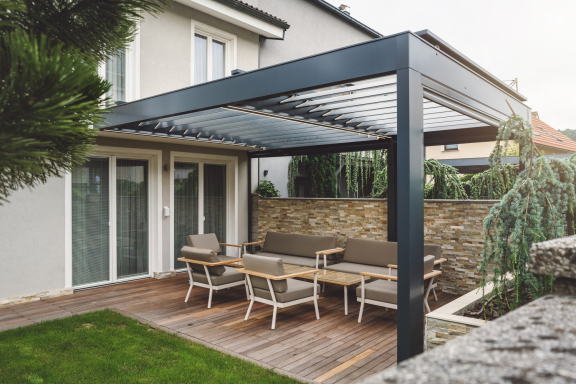
A bioclimatic pergola for optimal comfort in the event of bad weather
We've all, at one time or another, had to rush back into our homes to find shelter when we were relaxing on our terrace (alone, with our partner, with family or friends). Thanks to the bioclimatic pergola, you'll make the most of your terrace or your outdoor lounge area, whatever the weather. The wind and the rain (apart from in extreme cases) won't disturb your meals, your reading time, your friendly discussions over coffee, etc. You just need to close the adjustable slats (automated with a sensor or with a remote control) to turn your bioclimatic pergola into a traditional-style one that's totally closed-off. Likewise, the bioclimatic pergola provides a solution to the tricky issue of storing your outdoor furniture. When your bioclimatic pergola's adjustable slats are in the closed position, your garden furniture is protected from rainwater, meaning you don't need to rush around and move it into a garage or a garden shed.
A bioclimatic pergola that's easy to look after
This is the fourth key benefit of the bioclimatic pergola. As the bioclimatic pergola is made in aluminium, it doesn't require any special maintenance at any time throughout its service life. You just need to clean it from time to time with soapy water to keep its original exquisite gleam and look, and to remove any dirt. When compared with the traditional pergola and the wooden veranda (wood is known to be difficult to look after), the bioclimatic pergola yet again comes out trumps.
A bioclimatic pergola that's easy to install
You're not all that keen on DIY or manual work, and you like to see your outdoor spaces being transformed without any major hassle? Well, once again, the bioclimatic pergola's the perfect solution for your outdoor space design project. If you chose a veranda, you'd need to first create foundations and a concrete slab to set it on, whereas a bioclimatic pergola reigns supreme on just a few concrete posts. No need to dig trenches or get rid of huge amounts of earth to see a bioclimatic pergola in your garden. And, practically-speaking, it's often much quicker to set up a bioclimatic pergola than to install a traditional veranda. As the work doesn't take as long, you'll be able to enjoy your equipment in no time at all. And, you can then choose how you'd like to cover the ground of your bioclimatic pergola (composite terrace-type slatting or decking, outdoor tiling, etc.) if there's nothing already in place, and as such create a ground-look that suits you perfectly.
